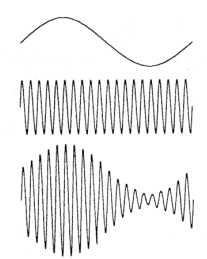Wireless Fundamentals: Modulation
Modulation is the act of changing a signal to transmit useful data. There are three aspects of a signal that can be modulated; amplitude, frequency, and phase. The amplitude is the power or intensity of the signal, the frequency is how often the signal repeated itself, and the phase describes where in the cycle the waveform is with respect to time.
This article discusses the topic of modulation, and describes how it is relevant to wireless communication.
Modulation Types
Amplitude Modulation
Wireless signals originally only had a single carrier frequency, that carrier frequency would be modulated to impose the data on it. Amplitude Modulation (AM), used for AM radio, uses a high speed carrier frequency and imposes the signal onto the carrier by adjusting the carrier's amplitude. In the diagram below, the signal that needs to be sent is on top. It is then combined with the carrier frequency in the middle resulting in the bottom waveform, which is sent out of the antenna.

Frequency Modulation
Phase and Frequency Modulation are the two other types of modulation that can be used to impose data onto a carrier frequency. Frequency modulation (FM) is used for everyday FM radio. The signals are imposed into the carrier by adjusting the frequency of the carrier. In the diagram below, the signal that needs to be sent is the on top. It is then combined with the carrier frequency in the middle resulting int the bottom waveform which is sent out of the antenna.

Digital Modulation
The above examples show the use of Amplitude and Frequency Modulation to carry an analog signal. Analog signals consist of the raw information and do not relate to digital 1s and zeros. A constellation diagram is used to relate discrete digital values to different changes in the analog carrier. The constellation diagram below is for an 8PSK modulation scheme. The distance from the origin of the graph describes the amplitude of the signal. All of the signals on the below constellation diagram are the same distance from the origin, meaning that the modulation scheme doesn't use any amplitude modulation. The angle from the "I" axis to where the point is on the diagram shows the phase offset that the signal would have to represent that particular value. The carrier would be only phase modulated which is called Phase Shift Keying (PSK). A digital modulation scheme that incorporates both Phase and Amplitude modulation is referred to Quadrature Amplitude Modulation (QAM).

Example PSK Modulation
To demonstrate the modulation an 8PSK modulator is used in the following block diagram. The example bit stream on the left hand side enters the modulator and has a bit slot of 10. Being a sample of 60 seconds and a bit slot of 10 seconds, the sample bit stream is carrying 6 bits (1 1 1 0 1 0). The 8PSK modulator clocks in 3 bits at a time to generate the modulated PSK signal. The PSK modulator relates the 3 clocked bits to its constellation diagram and generates a PSK waveform. Because it clocks in 3 bits to ever state change, the RF signal is 1/3 the rate of the bit stream. The entire process is depicted below and can be applied to any modulation scheme and bitrates.

Code Rate
The example above is using full rate modulation. In many cases, a half code rate scheme will be used in conjunction with the modulation scheme such that only half of the bits would change every bit-slot. Using a half code rate or even a 3/4 code rate helps ensure that the probability of an error in transmission or detection is low.
Frequency Spectrum Usage as a Result of Modulation
As the carrier is modulated, additional frequency components are created. Without these extra frequency components, the received signal would not resemble the original transmitted signal. These side-bands define a definite signal physical spectrum bandwidth. The required physical bandwidth of a signal is determined by the maximum modulation frequency and how drastic the state change could be. An example of how far the side bands would be in the worst case scenario is in the diagram below, where none of the spectral energy is in the carrier waveform. A Fourier Transform determines the spectral components of this worst case scenario signal. The power contained in the initial side bands is just a fraction of the carrier power and additional side-bands at harmonics will contain some of the power.


